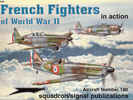Morane Saulnier MS 405
|
|
The M.S. 405 was developed in response to a French fighter specification of July 1934. Although it was a monoplane, in other ways it was an old fashioned aircraft. While Supermarine and Messerschmitt were using all-metal stressed skin constructions, where the metal surface of the fuselage provides structural strength, Morane Saulnier built their aircraft using technology familiar from earlier biplanes. Structural strength was provided by a series of bulkheads connected by aluminium tubes, connected by wire-braced struts. The aircraft was skinned with Plymax, a composite of plywood and aluminium. In some ways it resembled the Hawker Hurricane, built using similar methods.
One difference was that the M.S. 405 only carried three guns – one 20 mm cannon mounted in the engine and two 7.5 mm machine guns in the wings. This would make it badly under armed in 1940.
The first prototype flew on 8 August 1935, powered by an Hispano Suiza 12Ygrs engine. Its top speed was 298 mph at 13,120 feet, a good speed for 1935. However, the development process would take three years. The second prototype did not appear until January 1937, powered by an improved H.S 12Ycrs engine. Test results were promising, and on 1 March 1937 the French placed an order for 16 pre-production models.
The first of these, M.S. 405 No. 1, flew on 3 February 1938 at Centre d’Essais de Matériel Aérien (CEMA). No. 2 was sent to Rheims for operational tests. It was now decided to change the engine again, to the H.S. 12Y-31. With this engine change the designation was changed to M.S. 406, and it would be this version that entered mass production. The first order for the M.S. 406 was placed in April 1937, and the next month M.S. 405 No. 4 flew with the new engine.
Three of the pre-production M.S. 405s were used for experiments that resulted in new designations. No.3 had the fuel tanks moved from the fuselage to the wings, to make space for a compartment for a dummy parachutist. This was designated the M.S. 407 L.P.
No. 12 was given a H.S. 12Y-45 engine, and redesignated as the M.S. 411. This version first flew on 24 January 1939. The H.S. 12Y-31 had a retractable radiator, while the -45 had a standard fixed radiator.
Finally, No. 13 had the same fixed radiator as No.12, and compartments in the wings to hold flares. It was given the designation M.S. 408, and was constructed for the Swiss government, who had purchased a license to produce the M.S. 405. Eighty two were these aircraft were produced by the Swiss as the D-3800. The Swiss also produced 207 D-3801s, using an improved Hispano-Suiza 12Y-S1 engine, produced under license. This engine produced 1,000 hp, and had better performance than the French M.S. 406, reaching a top speed of 325 mph at 13,950ft.
 French Fighters of World War II, Alain Pelletier. This book tells the story of the French fighter aircraft that attempted to stand up the Luftwaffe in 1940. It covers seven main aircraft and a larger number of minor variants. Each aircraft is taken from development and prototypes through the battle of France and into the period after the armistice. [see more]
French Fighters of World War II, Alain Pelletier. This book tells the story of the French fighter aircraft that attempted to stand up the Luftwaffe in 1940. It covers seven main aircraft and a larger number of minor variants. Each aircraft is taken from development and prototypes through the battle of France and into the period after the armistice. [see more]